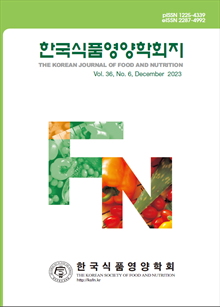간행물
한국식품영양학회지 KCI 등재 The Korean Journal of Food And Nutrition

- 발행기관 한국식품영양학회
- 자료유형 학술지
- 간기 격월간
- ISSN 1225-4339 (Print)2287-4992 (Online)
- 수록기간 1988 ~ 2024
- 주제분류 자연과학 > 생활과학 자연과학 분류의 다른 간행물
- 십진분류KDC 594DDC 641
권호리스트/논문검색
Vol. 28 No. 3 (2015년 6월) 22건
21.
2015.06
구독 인증기관 무료, 개인회원 유료
The aim of this study was to investigate the changes in the taste components of cheonggukjang made with germinated soybeans, which is produced by the addition of a smoking process. The total organic acid content of smoked cheonggukjang made with germinated soybeans (SCGS) was four times higher than that of non-smoked cheonggukjang made with non-germinated soybeans (NCNS). The total organic acid content of SCGS was lower than that of non-smoked cheonggukjang made with germinated soybeans (NCGS). The total free sugar content of NCGS and SCGS was approximately three times higher than that of NCNS. The total free amino acid content of NCGS was significantly decreased compared with that of NCNS, whereas the total free amino acid content of SCGS was 1.2 times higher than that of NCGS. The essential amino acid content of SCGS was significantly increased compared with that of NCGS. The ratio of glutamic acid to the total free amino acid in NCNS and SCGS was 19.6%. Similarly, the ratio of glutamic acid to the total free amino acid in NCGS was 19.1%. There were no significant differences in the total fatty acid content of NCNS, NCGS, and SCGS. The sensory evaluation of appearance, aroma, taste, and overall quality of SCGS was significantly increased compared with that of NCNS and NCGS. These results suggest that smoked cheonggukjang made with germinated soybeans could be utilized for the development of a novel fermented food.
4,000원
22.
2015.06
구독 인증기관 무료, 개인회원 유료
This study investigated the quality characteristics and antioxidant activities of wet noodles as well as their cooking properties following the addition of peanut sprout extract (PSE) and powder (PSP), which are known to contain a significant level of resveratrol. Wet noodles were prepared with 0, 2.5, 5, 7.5 and 10% PSE and PSP. Quality characteristics such as increasing volume of noodle, water ratio, turbidity of cooking water and color, texture, and sensory evaluation were then assessed. Additionally, the total resveratrol content in the cooked noodles was analyzed by HPLC and DPPH free radical scavenging capacity. As the amount of PSE and PSP increased, the L value of wet and cooked noodles significantly decreased, whereas the a and b values increased (p<0.001). The L value of cooked noodles was significantly lower compared to wet noodles (p<0.001) whereas the a and b values were higher. For the cutting intensity properties of the cooked noodles, hardness was reduced with increasing amounts of PSE (p<0.001), and was significantly increased in proportion to the amount of PSP (p<0.05). Meanwhile, springiness was not significantly different in all groups. Total resveratrol content and free radical scavenging activity significantly increased in proportion to the amounts of PSE and PSP (p<0.001), especially in noodles containing 5%, 7.5% and 10% PSE and PSP. Finally, sensory evaluation of PSE noodle revealed that color, flavour, taste were significantly decreased (p<0.05). But there was no difference in overall acceptance among cooked noodles with 2.5% to 5% PSE comparison to the control. Sensory characteristics in the PSP noodle showed similar results. In conclusion, these findings suggest that peanut sprout extract and powder could be potentially used as functional food ingredients. In addition, up to 5% PSE and PSP can be substituted for wheat flour.
4,000원
1
2

